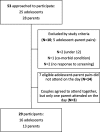Self-management needs of Irish adolescents with Juvenile Idiopathic Arthritis (JIA): how can a Canadian web-based programme meet these needs?
- PMID: 30409209
- PMCID: PMC6225653
- DOI: 10.1186/s12969-018-0287-0
Self-management needs of Irish adolescents with Juvenile Idiopathic Arthritis (JIA): how can a Canadian web-based programme meet these needs?
Abstract
Background: Juvenile Idiopathic Arthritis (JIA) affects over 1000 children and adolescents in Ireland, potentially impacting health-related quality-of-life. Accessible self-management strategies, including Internet-based interventions, can support adolescents in Ireland where specialist rheumatology care is geographically-centralised within the capital city. This study interviewed adolescents with JIA, their parents, and healthcare professionals to (i) explore the self-management needs of Irish adolescents; and (ii) evaluate the acceptability of an adapted version of a Canadian JIA self-management programme (Teens Taking Charge: Managing Arthritis Online, or TTC) for Irish users.
Methods: Focus groups and interviews were conducted with Irish adolescents with JIA (N = 16), their parents (N = 13), and Irish paediatric healthcare professionals (HCPs; N = 22). Adolescents were aged 12-18 (Mage = 14.19 years), and predominantly female (62.5%). Participants identified the needs of adolescents with JIA and evaluated the usefulness of the TTC programme. Data were analysed using a thematic analysis approach.
Results: Five themes emerged: independent self-management; acquiring skills and knowledge to manage JIA; unique challenges of JIA in Ireland; views on web-based interventions; and understanding through social support. Adolescents acknowledged the need for independent self-management and gradually took additional responsibilities to achieve this goal. However, they felt they lacked information to manage their condition independently. Parents and adolescents emphasised the need for social support and felt a peer-support scheme could provide additional benefit to adolescents if integrated within the TTC programme. All participants endorsed the TTC programme to gain knowledge about JIA and offered suggestions to make the programme relevant to Irish users.
Conclusions: There is scope for providing easily-accessible, accurate information to Irish families with JIA. The acceptability of adapting an existing JIA self-management intervention for Irish users was confirmed.
Keywords: Adolescence; Juvenile arthritis; Needs assessment; Online intervention; Self-management.
Conflict of interest statement
Authors’ information
None.
Ethics approval and consent to participate
This study was granted ethical permission by the
Consent for publication
Not applicable as no personal information is being reported in the article.
Competing interests
The authors declare that they have no competing interests.
Publisher’s Note
Springer Nature remains neutral with regard to jurisdictional claims in published maps and institutional affiliations.
Figures
Similar articles
-
Lending an Ear: iPeer2Peer plus Teens Taking Charge online self-management to empower adolescents with arthritis in Ireland: protocol for a pilot randomised controlled trial.BMJ Open. 2019 Dec 15;9(12):e027952. doi: 10.1136/bmjopen-2018-027952. BMJ Open. 2019. PMID: 31843817 Free PMC article.
-
Teens Taking Charge: A Randomized Controlled Trial of a Web-Based Self-Management Program With Telephone Support for Adolescents With Juvenile Idiopathic Arthritis.J Med Internet Res. 2020 Jul 29;22(7):e16234. doi: 10.2196/16234. J Med Internet Res. 2020. PMID: 32723728 Free PMC article. Clinical Trial.
-
Jointly managing arthritis: information needs of children with juvenile idiopathic arthritis (JIA) and their parents.J Child Health Care. 2012 Jun;16(2):124-40. doi: 10.1177/1367493511430679. Epub 2012 Feb 3. J Child Health Care. 2012. PMID: 22308541
-
Experiences of living with juvenile idiopathic arthritis: a qualitative systematic review.JBI Evid Synth. 2022 Jan 1;20(1):60-120. doi: 10.11124/JBIES-21-00139. JBI Evid Synth. 2022. PMID: 34669687
-
Harnessing interactive technologies to improve health outcomes in juvenile idiopathic arthritis.Pediatr Rheumatol Online J. 2017 May 16;15(1):40. doi: 10.1186/s12969-017-0168-y. Pediatr Rheumatol Online J. 2017. PMID: 28511689 Free PMC article. Review.
Cited by
-
"I just want to be normal": A qualitative investigation of adolescents' coping goals when dealing with pain related to arthritis and the underlying parent-adolescent personal models.Paediatr Neonatal Pain. 2021 Dec 28;4(3):96-109. doi: 10.1002/pne2.12069. eCollection 2022 Sep. Paediatr Neonatal Pain. 2021. PMID: 36188161 Free PMC article.
-
A meta-ethnography of how children and young people with chronic non-cancer pain and their families experience and understand their condition, pain services, and treatments.Cochrane Database Syst Rev. 2023 Oct 5;10(10):CD014873. doi: 10.1002/14651858.CD014873.pub2. Cochrane Database Syst Rev. 2023. PMID: 37795766 Free PMC article. Review.
-
Supporting Primary School Children with Juvenile Idiopathic Arthritis: A Qualitative Investigation of Teaching Staff Experiences.Children (Basel). 2021 Jun 28;8(7):555. doi: 10.3390/children8070555. Children (Basel). 2021. PMID: 34203152 Free PMC article.
-
Patient and parent perspectives on transition from paediatric to adult healthcare in rheumatic diseases: an interview study.BMJ Open. 2021 Jan 4;11(1):e039670. doi: 10.1136/bmjopen-2020-039670. BMJ Open. 2021. PMID: 33397662 Free PMC article.
-
Families' Experiences With Family-Focused Web-Based Interventions for Improving Health: Qualitative Systematic Literature Review.J Med Internet Res. 2025 Jan 30;27:e58774. doi: 10.2196/58774. J Med Internet Res. 2025. PMID: 39883928 Free PMC article.
References
-
- Arthritis Ireland. JIA Facts 2017 [Available from: http://www.juvenilearthritis.ie/Parents/About-JIA/JIA-Facts/.
MeSH terms
Grants and funding
LinkOut - more resources
Full Text Sources
Medical


